Unlock Potential Through Curiosity
In a world of quick answers, it's knowing when to ask the right questions.

The most powerful tool in a leader’s arsenal isn’t the ability to provide all the answers—it’s knowing how to ask the right questions.
As leaders climb the ranks, they face increasing pressure to have solutions at their fingertips. Yet paradoxically, the higher they rise, the more their success depends on drawing insights from others rather than supplying all the answers themselves.
According to research from Harvard Business Review, leaders who excel at asking questions rather than dictating answers create environments where innovation thrives and problems get solved more effectively (Hagel, 2021). “The best teachers all have at least one thing in common: they ask great questions,” notes James Ryan, former dean of the Harvard Graduate School of Education.
What Questions Unlock
When leaders embrace curiosity and inquiry, they unlock a Questioning Culture.
1. Deeper Understanding Questions penetrate beyond surface-level information, revealing underlying patterns, motivations, and opportunities that might otherwise remain hidden.
2. Greater Team Engagement When team members are asked for their perspectives rather than simply told what to do, they become invested in solutions and outcomes.
3. Better Problem Detection Questions help teams identify potential issues before they become crises, particularly when leaders create an environment where questioning the status quo is encouraged.
4. Continuous Learning A culture of questioning creates an environment where learning becomes embedded in daily work rather than reserved for formal training.
“Any answer is only as good as the question asked. Yet it’s not always easy asking good questions. It requires us to look beyond simple solutions and to encourage colleagues to do the same.”
— James E. Ryan
Types of Questions and Their Impact
The specific wording and structure of your questions dramatically affects how people respond. Let’s lay the groundwork for the rest of this article as understanding these impacts helps you select the right question type for your objective.
Binary Questions
- Structure: Can be answered with yes/no or either/or
- Example: “Is this approach working?”
- Impact: Limits response options, can shut down exploration
- Best used for: Confirming decisions, checking status quickly
Leading Questions
- Structure: Contains assumptions or suggests the desired answer
- Example: “Don’t you think we should prioritize project X?”
- Impact: Biases responses, signals your preference
- Best used for: Rarely beneficial, but occasionally to gently guide in a crisis
Open-Ended Questions
- Structure: Cannot be answered with yes/no
- Example: “What are we learning from this situation?”
- Impact: Invites elaboration, expands thinking
- Best used for: Exploration, idea generation, deeper understanding
Reflective Questions
- Structure: Prompts consideration of thinking process or assumptions
- Example: “What assumptions are we making that we haven’t examined?”
- Impact: Surfaces hidden beliefs, encourages critical thinking
- Best used for: Breaking through stuck patterns, challenging status quo
Scaling Questions
- Structure: Asks for rating on numerical scale
- Example: “On a scale of 1-10, how confident are we in this approach?”
- Impact: Provides measurement, highlights differences in perception
- Best used for: Converting abstract concepts to concrete evaluations
Choosing the Right Questions for Your Purpose
Different situations call for different types of questions. Many leaders default to a single questioning approach regardless of context, which can limit team thinking and outcomes. Understanding when to deploy which type of question can dramatically improve your leadership effectiveness.
Effective questions can be categorized along two dimensions: time focus (past vs. future) and purpose (problem-oriented vs. possibility-oriented).
Past-Focused, Problem-Oriented Questions
When to use: Diagnosing issues, understanding root causes, or learning from mistakes
- “What factors contributed to this outcome?”
- “What did we miss in our initial assessment?”
- “How did similar situations unfold previously?”
These questions help teams learn from experience but should be balanced with forward-looking questions to avoid dwelling on problems.
Past-Focused, Possibility-Oriented Questions
When to use: Identifying strengths, capturing learning, or recognizing underutilized resources
- “What strengths did this situation reveal about our team?”
- “What unexpected positive outcomes emerged?”
- “What approaches worked well that we might replicate?”
These questions extract valuable lessons and assets from past experiences.
Future-Focused, Problem-Oriented Questions
When to use: Anticipating challenges, mitigating risks, or preparing for difficulties
- “What obstacles might we face in implementing this approach?”
- “How might this decision create unintended consequences?”
- “What perspectives or data points might we be overlooking?”
These questions help teams proactively address potential issues before they occur.
Future-Focused, Possibility-Oriented Questions
When to use: Brainstorming solutions, creating vision, or expanding thinking
- “What might be possible if resource constraints were removed?”
- “How could we approach this differently to create breakthrough results?”
- “What would make this a wildly successful initiative?”
These questions generate energy and expand the range of options considered.
The most effective leaders develop fluency across all four quadrants, deliberately choosing which type of question to ask based on the team’s current needs and the specific challenge they’re addressing.
The Question Funnel: Driving to Action Through Progressive Inquiry
When tackling complex problems, structuring your questions in a funnel pattern can help move from broad exploration to specific action. This technique mirrors the famous “Five Whys” approach but expands it to address both problems and possibilities.
Begin Broad: Exploration Questions
Start with questions that open up possibilities and establish context:
- “What’s happening in this situation?”
- “What factors might be influencing these outcomes?”
- “What perspectives should we consider?”
Narrow Focus: Analysis Questions
Move to questions that evaluate and prioritize:
- “Which of these factors has the greatest impact?”
- “What patterns do we notice across these situations?”
- “Where do we have the most leverage for change?”
Target Solutions: Option-Generation Questions
Shift to questions that begin framing potential approaches:
- “What approaches might address these key factors?”
- “How have others successfully handled similar situations?”
- “What would a completely different solution look like?”
Get Specific: Decision Questions
Focus on evaluating and selecting among options:
- “Which approach best addresses our priorities?”
- “What criteria should we use to evaluate these options?”
- “What risks do we need to mitigate with this approach?”
Drive Action: Implementation Questions
Conclude with questions that create momentum and commitment:
- “What specifically will we do first?”
- “Who needs to be involved in each step?”
- “How will we know if our approach is working?”
Moving through this question funnel helps teams stay focused while still exploring issues thoroughly. It prevents both premature closure (jumping to solutions too quickly) and analysis paralysis (endless exploration without action).
When using the funnel approach, resist the urge to skip steps. Teams often want to jump straight to solutions before fully understanding the situation. The richest insights typically emerge from moving deliberately through each level, allowing enough time at each stage for thoughtful consideration.
This structured approach to questioning is particularly valuable when addressing complex issues where the path forward isn’t immediately obvious. By guiding the team through a progressive inquiry process, you help them build a shared understanding of both the challenge and the solution.
Key Tips for Using the Question Funnel
- Resist the urge to skip steps - Teams often want to jump straight to solutions before fully understanding the situation
- Move through the funnel deliberately - Each level builds upon insights from the previous level
- Allow enough time at each level - Early stages (exploration and analysis) typically need more time than later stages
- Revisit earlier levels when necessary - If new information emerges, be willing to step back up the funnel
Coaching a Culture of Inquiry
In organizations where questions are rare and information is siloed, how can leaders foster a culture of healthy curiosity?
These three techniques have worked well for me as a grounding point over the years.
1. Model It Yourself
Leaders set the tone. When executives demonstrate comfort with saying “I don’t know, but let’s find out” or “What am I missing here?”, they give permission for others to embrace curiosity too.
Start meetings with questions instead of statements. Rather than beginning with “Here’s what we need to do,” try “What options should we be considering?” This simple shift signals that diverse thinking is valued.
2. Reward Thoughtful Questions
Explicitly acknowledge and appreciate team members who ask insightful questions. When someone raises a question that exposes a blind spot or reveals a new opportunity, recognize that contribution publicly.
3. Create Structured Question Time
Build question-focused sessions into your regular rhythms. Whether it’s a dedicated portion of your weekly executive meeting or quarterly “What if” sessions where the team explores possibilities, creating space specifically for inquiry signals its importance.
Question-Driven vs. Answer-Driven Leadership
Now that you’ve got the foundation for types of questions, how to ask the questions, and how to model the behaviors, how does that come together in practice? That depends on you and you’re ability to not just ask questions, but to pause and listen without the need to “fill the silence” with your own answers.
The difference between question-driven and answer-driven meetings can be dramatic. How you open and facilitate discussions directly impacts team engagement, the quality of ideas generated, and ultimately the commitment to decisions made.
Answer-Driven Meetings
In answer-driven meetings, leaders typically:
- Present predetermined solutions at the start
- Ask for input primarily on execution details
- Maintain control over the direction and outcome
- Experience limited team participation and energy
Typical outcomes: Solutions are implemented as presented, but with limited team ownership, potential resistance during execution, and missed opportunities for improvement. The leader remains the bottleneck for future decisions.
Question-Driven Meetings
In question-driven meetings, leaders instead:
- Begin with exploratory questions about the situation
- Facilitate team discovery of root causes and solutions
- Encourage diverse perspectives and collaborative problem-solving
- Generate high energy and broad participation
Typical outcomes: Solutions are co-created by the team, resulting in high ownership and commitment, broader perspectives being considered, identification of underlying issues, and leadership capacity being built across the team.
While there’s certainly a time for decisive direction (particularly in crisis situations), regularly defaulting to the answer-driven approach limits your team’s potential contributions and development. By consciously shifting more of your meetings to a question-driven format, you’ll likely see increased engagement, more diverse thinking, and stronger commitment to implementation.
The key is recognizing which approach is most appropriate for the specific situation. When time is of the essence or when the team lacks critical information that only you possess, a more directive approach may be warranted. However, for complex problems that benefit from diverse perspectives or decisions that require strong team commitment, the question-driven approach will typically yield better results.
Building Your Question Toolkit
The ability to ask powerful questions isn’t innate—it’s a skill that develops with deliberate practice. Here are three exercises to strengthen your questioning muscles.
The Five Whys: When facing a problem, practice asking “why” five times in succession to get to root causes. (Just be careful not to use this approach in ways that could make team members feel defensive.)
Question Tracking: For one week, track the ratio of statements to questions in your leadership communications. Aim to gradually increase the proportion of thoughtful questions.
Question Partners: Pair up with another leader and commit to reviewing each other’s key questions before important meetings or decisions.
How to Know If You’re Asking Great Questions
Great questions shift energy and create movement. You’ll know your questioning approach is working when you observe:
- Increased participation in discussions from previously quiet team members
- More thoughtful pauses before responses—a sign of deeper consideration
- Follow-up questions from your team, indicating engaged thinking
- New solutions emerging that weren’t previously considered
The Lasting Impact
In organizations where questions flow freely and curiosity is celebrated, teams become more adaptable, more innovative, and more aligned. By making the shift from having all the answers to asking the right questions, you create space for collective intelligence to flourish.
The frameworks we’ve explored—the Question Matrix, Meeting Dynamics, Question Types, and the Question Funnel—provide structured approaches to mastering the art of inquiry as a leader. Each offers a different lens through which to understand and improve your questioning practice:
- The Question Matrix helps you select questions that balance past learning with future possibilities
- Understanding Meeting Dynamics illustrates how your approach shapes team engagement and outcomes
- The Question Types framework builds awareness of how different question structures impact thinking
- The Question Funnel provides a sequence for moving from exploration to committed action
Together, these tools form a comprehensive approach to questioning that can transform your leadership effectiveness. The key is consistent, deliberate practice—shifting from reactive habits to intentional choices about when, how, and what you ask.
The next time you find yourself in a critical meeting, try leading with a question instead of a statement. Experiment with a question type you typically underuse, or consciously move through the question funnel to guide your team from exploration to action. The resulting conversation might just surprise you.
What’s one powerful question you could ask in your next leadership meeting?
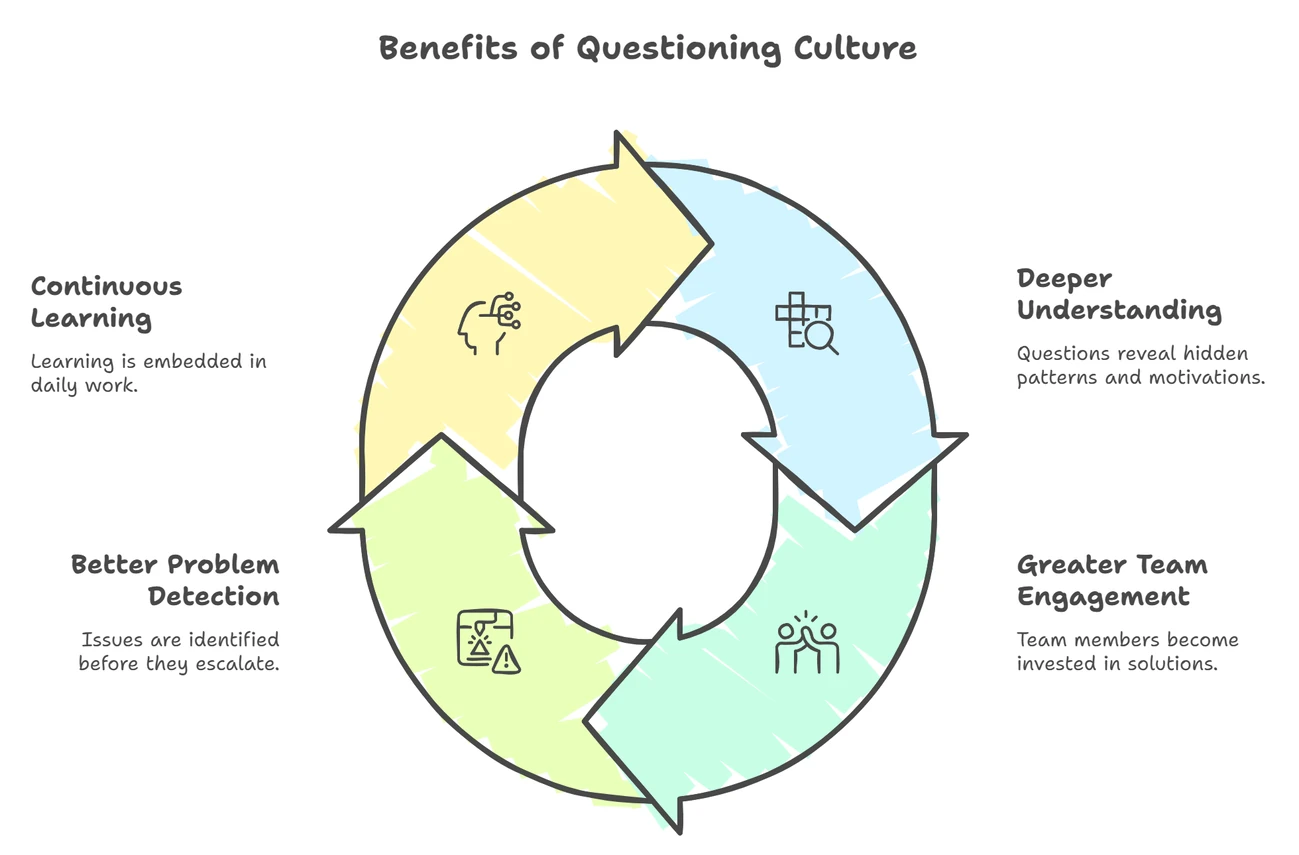
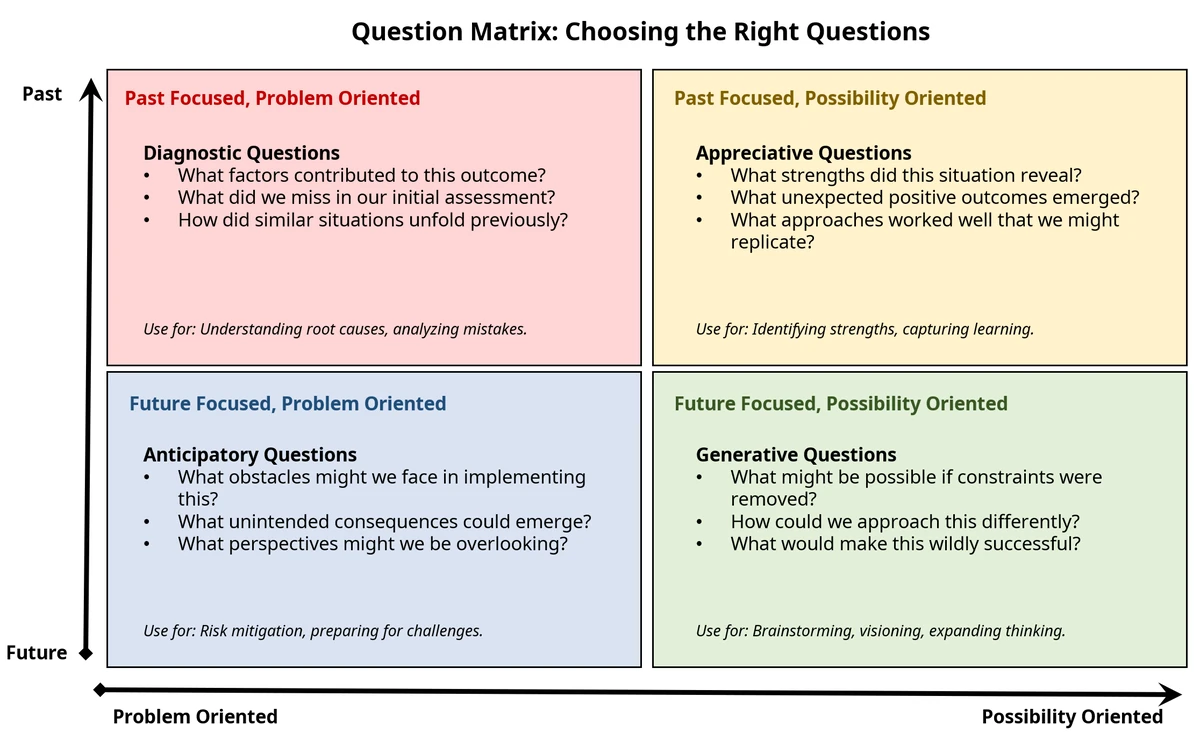
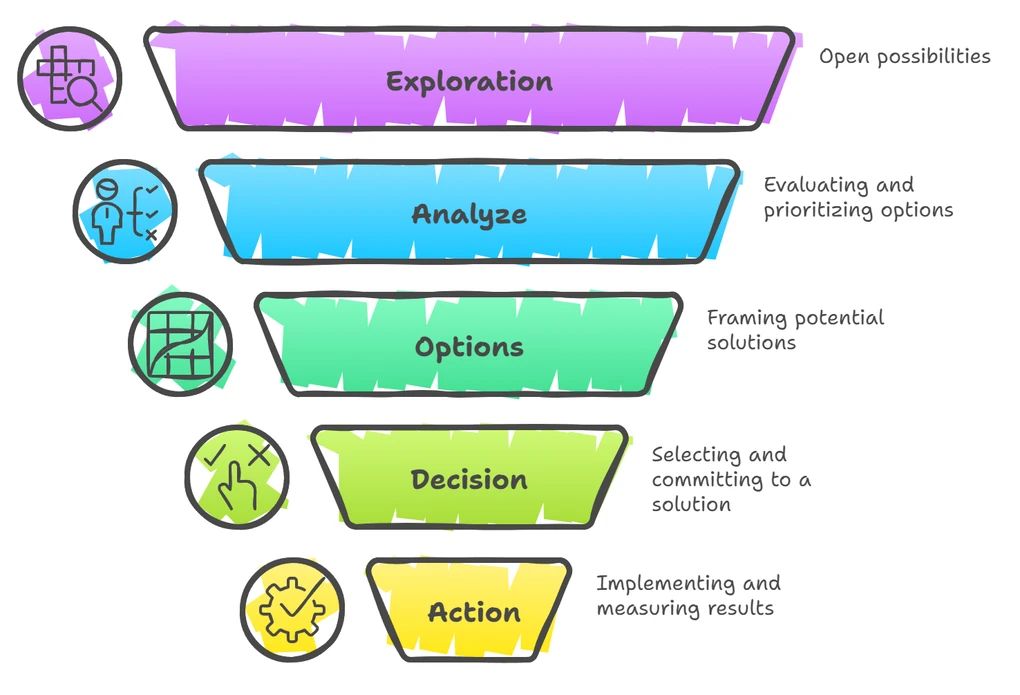
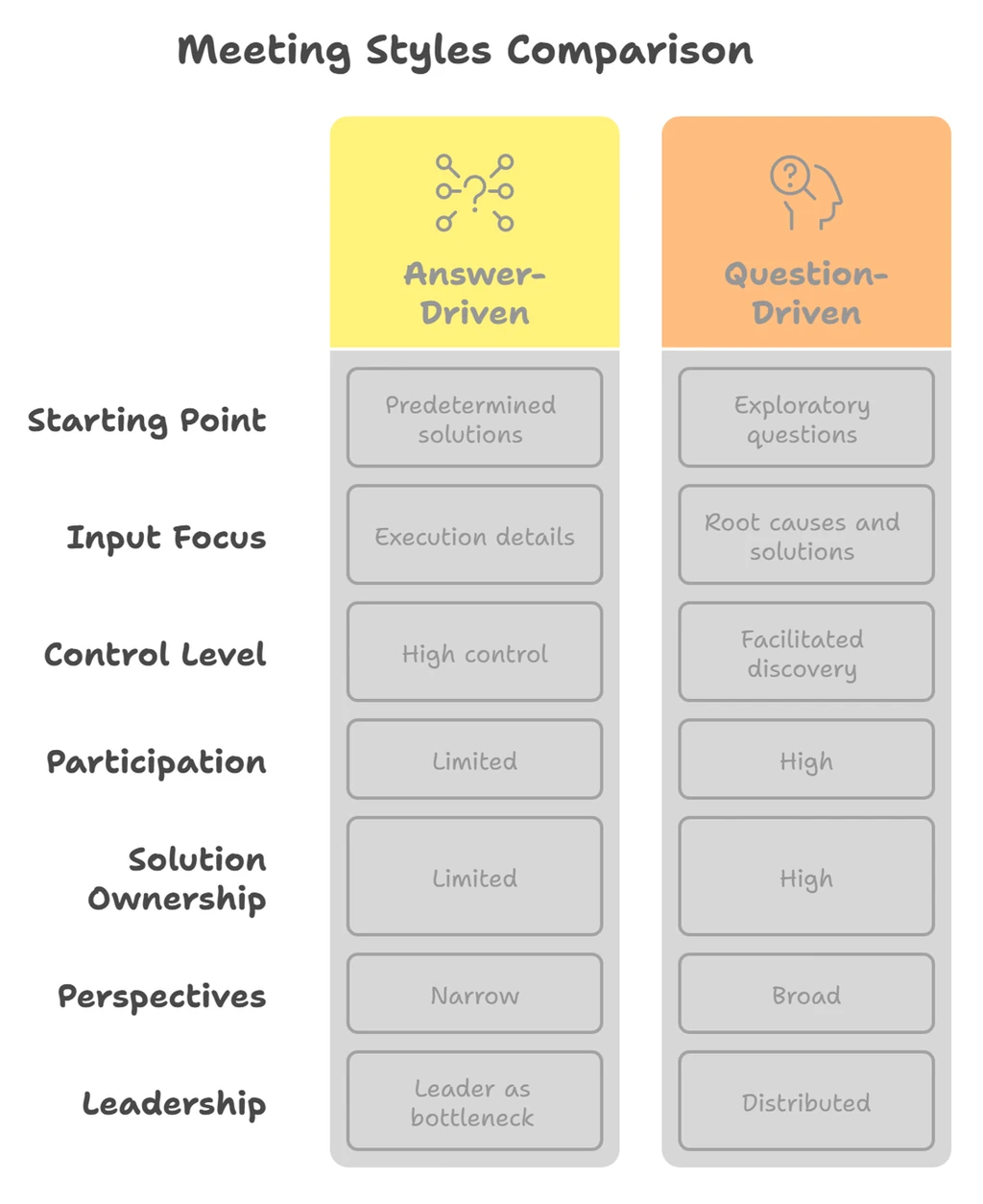


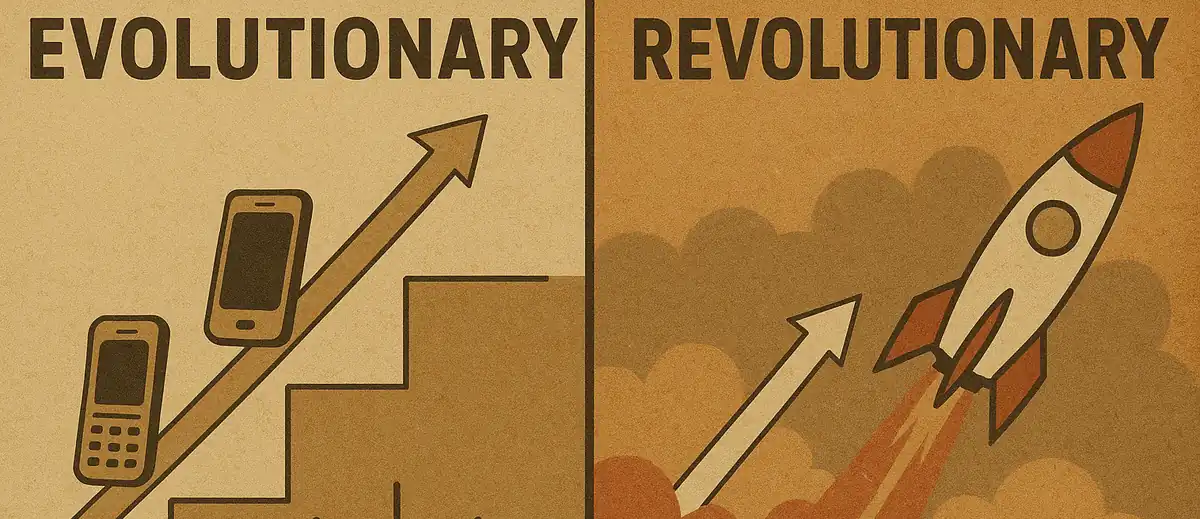




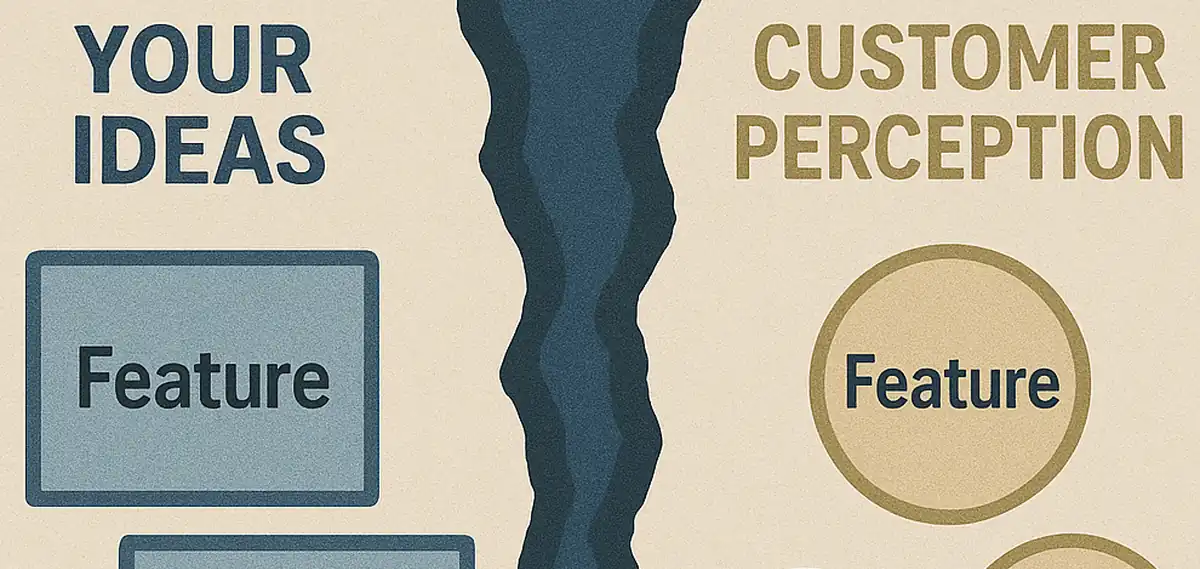

Share this post
Twitter
Facebook
Reddit
LinkedIn
Pinterest
Email